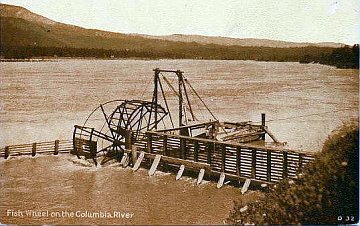~~* The Singing Falls Stream Restoration Project *~~
 ϕ
ϕ
~~* Landscaping with the watershed in mind *~~
Salmon don't spawn in your flower beds, but your yard may be affecting the salmon's habitat.
Good salmon stewardship can literally begin at home. Thousands of people up and down the West Coast are involved in the effort to restore the salmon's natural habitat in rivers and streams. But it is also important to remember that the water we use for everyday purposes on our own property is part of the salmon's habitat as well.
Salmon need clean water, and enough of if at the right times, in order to migrate, spawn and rear to adult stage to start the cycle again. Yet many rivers in the West run low, or even run dry, due to human demand. And many rivers are tainted by toxic chemicals that are potentially dangerous to sensitive juvenile fish.
Considering the large volumes of water that are withdrawn from rivers and streams for agriculture, industry, and direct human consumption, it can be easy to overlook the fact that decisions about home landscaping can have a significant impact on water supplies. During the summer months, for instance, 12% of a typical home's water use is wasted through over -watering the lawn. This translates into millions of gallons pumped unnecessarily from a stream or groundwater source serving even a small town.

Columbia River “Fish Wheel”
Homeowners wishing to make a major contribution to water conservation might consider “xeriscaping” -- the use of locally adapted, drought-resistant plants that need a minimum of watering. But homeowners can make their yards more salmon-friendly with any of the following steps:
Don't over-water or over-cut your lawn. Watering heavily once a week (to a depth of about one inch ) promotes deeper root growth and is more effective than numerous light waterings. Water before 10 a.m. to reduce evaporation. Longer grass blades shade the soil and retain moisture, so set your mower blades to leave grass about three inches long.
When landscaping, buy plants that are low water-users. If you use thirsty plants, group them together for efficient watering and mulch them well. Consider water-thrifty forms of ground cover, such as juniper or heathers.
Use mulch around plants to retain moisture, and keep weeds down so they won't add to water uptake.
Always sweep sidewalks, driveways and patios, rather than hosing them down.
Avoid use of toxic chemicals and pesticides in gardening. Minimize fertilizer use. Seek out information on organic alternatives. Garden chemicals can wash away into groundwater or streams.
For more information on what you can do at home to help salmon recovery efforts in the Pacific Northwest, please contact your local watershed restoration group, soil and water conservation district, or Pacific States Marine Fisheries Commission, 45 SE 82nd Dr., Suite 100, Gladstone, OR 97027-2522.
Stream Index
top






